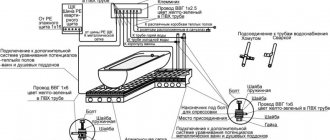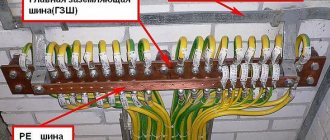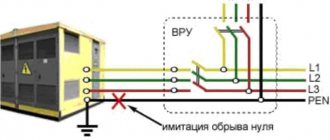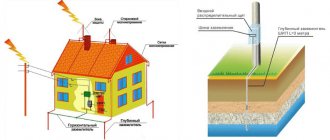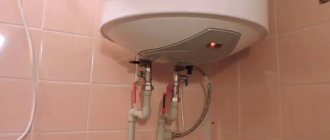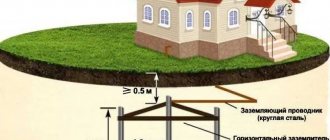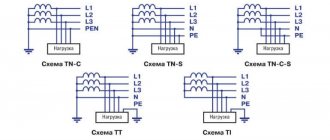Preventative work
The rules for the technical operation of consumer electrical installations, better known by the abbreviation PTEEP, provide for the prevention and repair of grounding. In order to determine whether outside intervention in the pipeline ground loop is necessary, maintenance personnel perform the following measures:
- For overhead communications, a visual inspection of the accessible part is carried out.
For underground communications, inspection is carried out by opening the soil.
Explosive areas
Some industrial plants are partially or entirely explosive because they use or produce flammable substances. But here’s what’s interesting here: in the process of physical friction of the liquefied substance against the walls of the pipes, natural grounding is created, but this, unfortunately, is not enough for safety. Therefore, in such cases, additional grounding is installed in some areas, using a wire without metal insulation, for example, an AAShV power cable, where aluminum wires in impregnated paper insulation are enclosed in a polyvinyl chloride sheath.
How to use this knowledge at home
Perhaps someone will ask themselves, why do I need such information if I’m not doing this? Well, such a person will be right, because at home there will be no need to ground process pipelines. But such a statement will be shaken if you look at the situation from the other side.
Zeroing the socket
In old houses built during the times of I. Stalin and N. Khrushchev, no grounding of any communications is provided. Therefore, some residents encountered problems such as a “breaking” washing machine or a “breaking” mixer. In both cases, the reasons are similar: a bare phase wire has come into contact with the ground.
Video description
TOP 10 mistakes in installing the Grounding device.
In the private sector
Grounding loops in the private sector can be made in different ways and this is a topic for a separate article, but here we will look at the basic principles of such a device. In most cases, a triangle is made, where a steel corner 50X50 mm or reinforcement Ø 10-14 mm is used as pins. They are welded together either with wire rod or a 20X5 mm steel strip at a distance of a meter. The approximate depth is from 2 to 3 meters, but this depends on the soil. The strip is carefully welded to the pins - the seam must only be of high quality.
Now, the most important thing: take the tester in your hands and measure the resistance between the two pins - it should not be more than 4 Ω, but the strip or wire from the house to the circuit should not be more than 0.1 Ω. In this case, you will never get an electric shock in the toilet, bathroom or kitchen when you use the water supply or sewer system.
Installation rules
Attention! All connections of the grounding system are made only by welding, where two elements or sections are overlapped. The quality of such a connection will be checked by hitting a kilogram hammer. Welded joints must be treated with bitumen-based varnish.
Now, regarding the wiring of grounding conductors. They can be carried out on concrete and brick structures, both in the horizontal and vertical planes. Fastening to structures is done with dowels, between which you can leave a distance:
- on straight sections in the range of 600-1000 mm;
- on bends and turns no more than 100 mm.
Do pipelines need to be grounded? and how can this be done?
According to GOST R 505 71 (M EK 364), grounding and grounding of pipelines must be carried out for all metal circuits associated with electrical installations > ≈ 42 V or > - 11V. For alternating and direct currents less than the specified values, grounding is not necessary. In fact, what we constantly encounter in life is somewhat larger than these numbers, therefore, it never hurts to know the instructions for installing grounding.
Such structures are grounded regardless of the material they are made of.
Grounding system terms
Before moving on to considering the rules for installing grounding, it is necessary to define the terms used by specialists when carrying out this type of work.
- Firstly, what is a grounding device? This is a structure consisting of a grounding conductor and grounding conductors.
- Secondly, what is a ground electrode? This is a metal conductor that is directly connected to the ground.
- Third, what are grounding conductors? This is a system of metal conductors that connect the ground electrode to electrical equipment.
Please note that grounding an electrical installation artificially is called intentional. There is such a thing as the resistance of a grounding device. This is, in fact, the sum of the resistances of the grounding conductor and grounding conductors. If we talk about the resistance of the ground electrode itself, then this is the voltage relative to the ground to the current passing through the metal conductor.
What the Electrical Installation Rules say
According to the Electrical Installation Rules, any technological equipment (including pipelines) must be grounded. Otherwise, the entire facility as a whole cannot be allowed to operate (grounding of pipelines PUE 1.7).
- A metal connection is provided along the entire length of the pipe circuit, regardless of the purpose and technical features of the laying.
- The grounding circuit is selected in accordance with the temperature of the material and the resistivity (denoted by ρ) of the soil at the installation site.
- The structure (above or underground) must be grounded at least at two points along its entire length.
- All communications along the path of the circuit must also be grounded. For example, all residential buildings connected to centralized heating, water supply and sewerage, even if the wiring in the buildings is made of PVC, PE, PPR.
Recommendation: if your house or apartment has water supply, sewerage and heating pipes made of PVC, PE and PPR, then the faucets in any case remain metal. When an electric boiler or washing machine goes to ground, all the taps of both you and your neighbors will be shocked. To prevent this from happening, adhere to PUE 1.7.76 (published below).
Next, we will briefly consider the grounding of pipelines according to paragraphs of PUE 1.7.
Clause 1.7.76
Protection against contact with the above-ground and root systems of trees applies to:
- enclosures: electrical machines, transformer substations, electrical supports, etc.;
- electric drives (for example, barriers, switches);
- electrical panel frames of any type;
- any metal structures of distribution devices, cables, couplings, hoses/pipes of electrical wires, etc.;
- metal cable sheaths, as well as pipes, boxes, trays, etc.;
- housings of mobile/portable electrical receivers;
- electrical equipment on moving parts of machines and mechanisms.
All of the above devices and installations must be connected to a common solidly grounded neutral in the system.
Clause 1.7.77
Connection to the neutral of the grounding system is not provided:
- housings of any electrical equipment installed on grounded platforms;
- all structures that have reliable contact with other grounded equipment;
- all removable or opening parts of equipment not exceeding ≈ 42 V or - 11 V (Clause 1.7.53);
- power line fittings and insulators;
- open conductive elements with double insulation;
- all metal fasteners with a total area of no more than 1 m2.
Do metal pipes need to be grounded?
Steel pipes for laying cables and wires are used in cases where the mechanical and thermal strength of plastic pipes is insufficient, as well as based on the conditions for ensuring the explosion and fire safety of installations and economic feasibility.
Both cables and insulated wires are laid in steel pipes. Personally, I prefer cables, because... The cable is double insulated and is more reliable in operation compared to wires. You also need to take into account that laying wires in a pipe is much more expensive than laying cables in a pipe. However, in some cases it makes sense to provide wires rather than cables. I think I’ll record a video on this topic on my channel.
When designing, I try to use metal pipes as a last resort, because... in accordance with the requirements of the PUE, metal hoses and steel pipes of electrical wiring are subject to grounding or grounding. And this is not very convenient.
At the same time, you should know that metal pipes and metal hoses are not always subject to grounding.
6) metal staples, fasteners, sections of pipes for mechanical protection of cables in places where they pass through walls and ceilings and other similar parts of electrical wiring with an area of up to 100 cm 2, including broach and branch boxes of hidden electrical wiring.
Grounding (grounding) of steel pipes is carried out at the beginning and at the end of the route by connecting grounding conductors to the grounding units of switchboards, consoles and junction boxes on one side and on the other side by connecting the pipes to grounded equipment. For grounding or grounding, as well as for connecting metal pipes to the potential equalization system, a grounding clamp is used:
Pipe grounding clamp
When laying cables and wires in metal pipes or metal sleeves, do not forget to ground them.
I recommend reading:
“Do metal pipes need to be grounded?”
“Both cables and insulated wires in a protective sheath are laid in steel pipes. Personally, I prefer cables, because... The cable is double insulated and is more reliable in operation compared to wires.”
An insulated wire in a protective sheath has the same design as a cable - cores, each with its own insulation, and a common protective sheath.
I suspect that you meant installation wires (they are insulated without a protective sheath and can be installed in pipes), and by “double insulation” - core insulation and a protective sheath.
Otherwise, it turns out to be some kind of nonsense: insulated wires in a protective sheath are no worse than a cable - they are also, as you put it, “double insulated.”
Which wire do you mean?
For Belarus, a similar clause of TCH 339-2011 will apply:
clause 4.3.5.2 (similar to the above clause from PUE-7)
“Which wire do you mean?”
For example: PVS - wire with insulated conductors in a protective sheath;
PuV/PuGV - installation insulated wire;
VVG - cable with insulated conductors in a protective sheath;
SIP is a self-supporting insulated wire.
I have not seen “double insulation” on any cable and wire product.)
PVA is essentially a cable, not a wire, and its scope of application is very limited.
“PVA is essentially a cable, not a wire, and its scope of application is very limited.”
I don’t know what the point is, but PVA is a wire and nothing else.)
And that’s not the point, actually, I just wanted to say that there is no “double insulation” on the cable, and it is not clear why a cable is more reliable than an insulated wire in a protective sheath if it is protected in the same way as a cable.
If you write honey on the outside, it will be sweet and nothing else))
It seems, Igor, you still don’t understand what we’re talking about.
Why are you picking on words? He called the cable sheath insulation. That’s the problem, it completely changes the meaning of the article. If the outer insulation of a cable is called a sheath, this does not mean that it conducts electric current. Any profession has its own jargon and most readers, I think, will understand what we are talking about.
Apart from the PVS, I haven’t heard anything intelligible from you.
If they say wire, then first of all they mean a single conductor. Does PVS have these? Where is PVA used?
A single conductor in insulation with an outer sheath is already a cable.
Where is the outer sheath of the wire PV1, PV3, APV, PuV, PuGV, PuGVV?
“Both cables and insulated wires in a protective sheath are laid in steel pipes. Personally, I prefer cables, because... The cable is double insulated and is more reliable in operation compared to wires.”
Well, then explain what you yourself wrote.)) What wires in a protective sheath did you mean?
“If they say wire, then first of all they mean a single conductor. Does PVS have these? Where is PVA used?”
This may be meant by a person who does not know other wires other than installation or similar ones. And I gave PVA as an example of a wire with a protective sheath. And such a wire is called multicore. If you don’t like this example, I can give you another: RKGM is a wire in insulation and a protective sheath.
What difference does it make where these wires are used - the main thing is that for their intended purpose. The point is that I did not understand your preference for cable versus insulated wires in a protective sheath. I understand that you mean PV1, PV3, APV, PuV, PuGV, PuGVV. But they don't have a protective shell. Then, either you described the wires incorrectly, or I don’t understand what wires you are talking about.
PS I am for the competent speech of specialists, so that they understand each other and do not confuse others, and leave “picking on words” to the students.
I meant ordinary (not specialized) wires in insulation without additional sheathing or outer braiding.
Pipe stands
Let's start with the fact that pipe stands, as a concept according to the PEU, do not play any role in the grounding of technological main pipelines, despite their cognate sound. Pipe stands are used for installation of insulated power wires (SIP) and their connection to switchboard units (CPU). These same boards can serve as distribution boxes for any objects (houses, power lines, pumping and boiler stations, etc.). In fact, even if the distribution from the transformer goes to a pumping station serving a centralized or autonomous water supply system, then PUE 1.7.76 on the grounding of electrical appliances and installations is triggered there.
Note: the pipe stand is not always made of pipe - it can also be a hollow profile with a square/rectangular cross-section, a steel angle or a channel.
APPLICATION AREA
7.4.1. This chapter of the Rules applies to electrical installations located in fire hazardous areas indoors and outdoors.
These electrical installations must also meet the requirements of other sections of the Rules to the extent that they are not modified by this chapter. The selection and installation of electrical equipment (machines, apparatus, devices) and networks for fire hazardous areas are carried out in accordance with this chapter of the Rules based on the classification of flammable materials (liquids, dusts and fibers).
Requirements for electrical installations of residential and public buildings are given in Chapter. 7.1, and for electrical installations of entertainment enterprises, club institutions and sports facilities - in Chapter. 7.2.
Installation features
Some grounding connections of the finished pipeline (at least many of them) will differ from each other, and this is not at all because the electricians do not comply with the PUE. The fact is that the operating conditions of such structures can be fundamentally different from each other.
Grounding of process pipelines that are installed directly in the building (basement) is carried out using an artificial building circuit intended for all technological electrical equipment that is there.
All pipes are grounded using this principle.
The grounding unit for a pipeline in buildings is done as follows: a metal clamp is welded or thrown onto the pipe, on which there is a mounting hole for a bolt with a nut and washer, which serves as a terminal for the circuit. All contact points, without exception, such as the pipe walls, clamp, terminal bolt with nut and washer, must be thoroughly cleaned and pressed tightly against each other to avoid oxidation and corrosion.
The cross-section of the ground loop, depending on the object, should be as follows:
- copper without mechanical protection: ≥ 4.0 mm2;
- copper with mechanical protection: ≥ 2.5 mm2;
- aluminum: ≥ 16.0 mm2.
In terms of the number of ohms, the circuit, taking into account the line voltage, should be:
- for three-phase power lines with a voltage of 220/380/660 V corresponds to 5/10/20 Ω;
- for single-phase power lines 127/220/380 V corresponds to 5/10/20 Ω.
Effect of insulation on pipelines
It is noteworthy that the grounding of metal pipelines, or more precisely, the quality and duration of their service life, is affected by the insulation of autonomous and centralized pipelines. The fact is that when installing a pipeline, the layer, first of all, cares about reducing heat losses, or about its integrity, therefore, all materials used for this purpose have low water permeability. When the structure is underground, there is almost no oxygen there, plus protection from moisture equals very slow corrosion of the metal, and the less it is, the longer all contacts of the circuit will remain constant.
For grounding pipelines above ground (heating mains, gas pipelines), similar methods and materials are used, only here thin film polymers and paint are the best protection against corrosion. For example, for heat pipes, polyethylene film with an external bitumen coating or polyurethane foam coating is often used (the second option is more expensive). But gas comes to our apartments through pipes that are simply painted, since methane (CH4) does not react to negative temperatures, therefore, does not need insulation. But in both cases there is anti-corrosion protection that is favorable for ground loops.
ELECTRIC LIFTING MECHANISMS
7.4.26. The degree of protection of the electrical equipment shell used for cranes, hoists and similar mechanisms must correspond to Table. 7.4.1-7.4.3.
7.4.27.
The current supply of lifting mechanisms (cranes, hoists, etc.) in fire hazardous areas of classes P-I and P-II must be carried out using a portable flexible cable with copper conductors, rubber insulation, in a sheath that is resistant to the environment. In fire hazardous areas of classes P-IIa and P-III, the use of trolleys and trolley busbars is allowed, but they should not be located above areas where flammable substances are placed.
Table 7.4.3
Preventative work
The rules for the technical operation of consumer electrical installations, better known by the abbreviation PTEEP, provide for the prevention and repair of grounding. In order to determine whether outside intervention in the pipeline ground loop is necessary, maintenance personnel perform the following measures:
- For overhead communications, a visual inspection of the accessible part is carried out.
- For underground communications, inspection is carried out by opening the soil.
- For both types, control measurements are performed to verify compliance with standards.
How to use this knowledge at home
Perhaps someone will ask themselves, why do I need such information if I’m not doing this? Well, such a person will be right, because at home there will be no need to ground process pipelines. But such a statement will be shaken if you look at the situation from the other side.
Zeroing the socket
In old houses built during the times of I. Stalin and N. Khrushchev, no grounding of any communications is provided. Therefore, some residents encountered problems such as a “breaking” washing machine or a “breaking” mixer. In both cases, the reasons are similar: a bare phase wire has come into contact with the ground.
To ground, you need to bridge the neutral terminal with the ground terminal
If the faucet breaks, it means that it is enough to reverse the polarity of the common wire that goes to the bathtub. If the washing machine is beating, you need to zero the socket. To do this, open the cover of the device where the unit is turned on, find the zero terminal (the indicator on it does not light up) and bridge it with one of the ground terminals. A good jumper will be made from an insulated copper wire with a cross section of 0.5-1 mm2. After this, the machine and the metal sewer will stop beating.
In the private sector
Grounding loops in the private sector can be made in different ways and this is a topic for a separate article, but here we will look at the basic principles of such a device. In most cases, a triangle is made, where a steel corner 50X50 mm or reinforcement Ø 10-14 mm is used as pins. They are welded together either with wire rod or a 20X5 mm steel strip at a distance of a meter. The approximate depth is from 2 to 3 meters, but this depends on the soil. The strip is carefully welded to the pins - the seam must only be of high quality.
Now, the most important thing: take the tester in your hands and measure the resistance between the two pins - it should not be more than 4 Ω, but the strip or wire from the house to the circuit should not be more than 0.1 Ω. In this case, you will never get an electric shock in the toilet, bathroom or kitchen when you use the water supply or sewer system.
Effect of insulation
The insulation resistivity indicator can significantly influence the characteristic features of the pipeline. According to studies, the level of resistance in the grounding of a pipeline using bitumen insulation can greatly depend on the potential difference between the soil and the pipeline itself.
If the difference varies within a few hundred volts, glow discharge may occur at defective locations, which in turn reduces the ground resistance. If the potential difference is one kilovolt or more, an arc discharge appears between the soil and the pipeline.
It, accordingly, greatly reduces the resistance of the installed grounding. Portable grounding can also be used, in which the clamp is the main part.
Grounding of pipelines
During operation, pipeline networks experience mechanical, chemical, and temperature loads. Underground sections of the line are exposed to static electricity accumulated in the ground. Pipes that are laid above ground are affected by atmospheric electrical discharges and can also be struck by lightning. To protect consumers and service personnel of the branch from static electricity, the main line is grounded. The procedure effectively prevents the negative impact of electrical discharges on transported materials.
The term “grounding electrode” refers to a metal conductor that is in direct contact with the ground.
DEFINITIONS. GENERAL REQUIREMENTS
7.4.2. A fire hazardous zone is a space indoors and outdoors, within which flammable (combustible) substances are constantly or periodically circulating and in which they can be located during normal technological processes or during its disturbances.
The classification of fire hazardous areas is given in 7.4.3-7.4.6.
7.4.3. Class P-I zones are zones located in rooms in which flammable liquids with a flash point above 61 ° C are handled (see 7.3.12).
7.4.4. Class P-II zones are zones located in rooms in which flammable dust or fibers with a lower flammable concentration limit of more than 65 g/m3 to air volume are emitted.
7.4.5. Class P-IIa zones are zones located in rooms in which solid flammable substances are handled.
7.4.6. Class P-III zones are areas located outdoors in which flammable liquids with a flash point above 61°C or solid flammable substances are handled.
7.4.7. Zones in premises and areas of outdoor installations within a range of up to 5 m horizontally and vertically from the apparatus, in which flammable substances are constantly or periodically circulating, but the technological process is carried out using open fire, hot parts, or the technological apparatus has surfaces heated to the self-ignition temperature of flammable substances vapors, dusts or fibers are not classified as fire hazards in relation to their electrical equipment. The class of the indoor environment or outdoor environment outside the specified 5-meter zone should be determined depending on the technological processes used in this environment.
Indoor areas and outdoor areas in which solid, liquid and gaseous flammable substances are burned as fuel or disposed of by combustion are not classified as fire hazardous in terms of their electrical equipment.
7.4.8. Zones in the rooms of exhaust fans, as well as in the rooms of supply fans (if the supply systems operate using air recirculation), serving rooms with fire hazardous zones of class P-II, also belong to fire hazardous zones of class P-II.
Areas in the premises of local exhaust fans are classified as fire hazardous areas of the same class as the area they serve.
For fans installed behind external enclosing structures and serving fire hazardous zones of class P-II and fire hazardous zones of any class of local suction, electric motors are selected as for fire hazardous zones of class P-III.
7.4.9. Determination of the boundaries and class of fire hazardous zones should be carried out by technologists together with electricians of the design or operational organization.
In premises with production facilities (and warehouses) of category B, electrical equipment must, as a rule, meet the requirements of Ch. 7.4 to electrical installations in fire hazardous areas of the corresponding class.
7.4.10. When individual fire-hazardous equipment is placed indoors or outdoors, when special measures against the spread of fire are not provided, the area within 3 m horizontally and vertically from this equipment is a fire hazard.
7.4.11. When choosing electrical equipment installed in fire hazardous areas, it is also necessary to take into account environmental conditions (chemical activity, precipitation, etc.).
7.4.12. Fixed contact connections in fire hazardous areas of any class must be made by welding, crimping, soldering, screwing or another equivalent method. Demountable contact connections must be equipped with a device to prevent self-unscrewing.
7.4.13. Protection of buildings, structures and outdoor installations containing fire hazardous areas from direct lightning strikes and its secondary manifestations, as well as grounding of equipment installed in them (metal vessels, pipelines, etc.) containing flammable liquids, powdery or fibrous materials, etc. etc., to prevent sparking caused by static electricity, must be carried out in accordance with current standards for the design and installation of lightning protection of buildings and structures and the protection of installations from static electricity.
In fire hazardous areas of any class, measures must be taken to remove static charges from equipment.
7.4.14. Grounding of electrical equipment in fire hazardous areas must be carried out in accordance with Chapter. 1.7.
PUE rules
In Russia, there is a document “Rules for the Construction of Electrical Installations”, which regulates methods of protecting external and internal engineering facilities from dangerous charges. It states that these procedures must be completed before putting process pipelines into operation. Thanks to this, a level of safety is ensured during repair work and laying the route.
All types of internal communications are grounded at the points of entry into the structure. For example, this also applies to heating lines in residential buildings. They can also carry current and pose a danger to others.
So, what are the requirements for the systems?
- it is important to ensure a constant metal connection (continuous electrical circuit) along the entire length of the communication;
- the type of grounding loop must correspond to the resistivity of the soil in the installation area and the spreading current of the installation;
- the route is connected to the grounding loop in several places (at least two points). The exact number of such points depends on the technical characteristics and the length of the highway.
Copper wire
One of the most popular methods of protection is the installation of copper wire or conductor on the outside and inside of the line. They form a continuous electrical network. Jumpers are installed on routes that include flange connections.
Copper wires of the PVZ or PuGV brands are used as the basis for the wire. The wire diameter is usually from 1 to 1.5 mm. Special tips are fixed at the ends of the wire by pressing. Wafer jumpers are secured to the pipe itself with bolted fasteners. Sometimes the cold soldering technique is used for connection.
Pipe stands
With their help, they install an input device into a private country house or administrative building. The purpose of the pipe stand is to fix the installation of the shield itself and the power wires that lead to it.
The PUE indicates that a metal pipe stand must be grounded. They protect not only it from current, but also the shield, the zero bus. When performing the operation, select a green-yellow wire PV-3 with tips.
Explosive areas
Gas, alcohol-containing liquids and other fire hazardous products are often transported along highways. How are explosive areas protected during the construction of oil and gas pipelines?
Firstly, the safety standards required to be observed are contained in the “Rules for the Construction of Electrical Installations”. Secondly, natural grounding agents are used. These include:
- metal structures of buildings and structures that go deep into the ground;
- underground communication systems made of metal (for example, wells, sewers, water pipelines). But underground objects can be used as a natural grounding conductor only if its pipe sections have been connected by electric or gas welding. The PUE prohibits the adaptation of gasoline, gas, and oil pipelines for these purposes.
When explosive workshop premises are located on the territory of large production facilities, specialists are faced with the task of high-quality removal of static electricity. It occurs when friction occurs under the pressure of a liquid substance against the wall of a steel pipe. An effective measure to reduce potential carryover is the use of cable conductors with a non-metallic sheath (for example, AAShV brand).
Grounding of the gas pipeline PUE
In the process of laying pipelines for any purpose, it is necessary to take care of the safety of their operation.
It is important to prevent the negative impact of a strong electrical discharge on both the pipeline itself and the substances transported through it.
Especially for this it is important to install grounding.
Main features
When installing a grounding system, a connection to the building's lightning protection system is necessary.
With its help, possible impact on the raw materials transported inside is completely eliminated.
This is especially true in cases where there is an explosive substance inside - gas, oil, alcohol and other flammable materials.
To ground the pipeline, it is necessary to connect the current-carrying strip to a grounded metal object. Copper wire is used for this, since copper is considered an excellent conductor. At least one grounding connection is made for every twenty meters.
If the main line is assembled from a paper-metal pipe, the metal shells must be connected to each other, as well as to the bodies of boxes, electrical receivers or boxes. When performing work, you will need jumpers made of bare copper conductor with a good margin of flexibility.
Experts recommend using conductors with a cross-section of at least 2.5 square meters.
Moreover, you cannot save in this regard, even paying attention to the high cost of copper.
It is enough to secure it at each end of the pipes using a wire bandage, or by soldering the outlet to the body and the pipe itself using a soldering iron.
It is important to remember that for proper grounding, metal parts should be installed every 20 meters. In this case, they will also have to be permanently connected using a tap.
Copper wire
Practice shows that the most popular method by which pipelines are grounded is the use of copper wire. It is recommended to use wire with a diameter of 1...1.5 mm.
It is carried out both from the inside and from the outside, fastening it together at the joints using a wire jumper. The cold soldering method is used for connection.
The outer wire installed at the end point needs to be carefully grounded.
Grounding the pipeline is the simplest, but at the same time mandatory, method of removing accumulated static charges of electricity.
Flange grounding of pipelines
It is performed to ensure continuity of the electrical circuit. For fixation, conductive copper strips are taken, which are attached to steel pipes with bolts. To determine the location and methods of connecting protective conductors, preliminary calculations are carried out. Incorrectly performed work will lead to the automation being turned off or its incorrect functioning. The jumpers are made from the same copper PuGV or PVZ.
When the installation is completed, specialists measure electrical resistance and sign an inspection report. Optimal resistance indicators for networks with a certain voltage are fixed in the PUE.
Preparation for repair
In preparation for repair work, it is necessary to free the pipeline from the transferred substance, and then purge it with special technical nitrogen. It is worth making sure there is grounding.
If the design does not provide for the installation of a temperature condenser, flushing with water steam is strictly prohibited. This will lead to an increase in internal pressure, which leads to rupture of the structure. Thus, the heating system will fail.
For a long time, to ensure continuity of grounding of installed steel pipes, shunt jumpers were used, mounted on boxes, fittings or special couplings. After the tests, it turned out that this is not necessary. The grounding circuit of the finished pipeline becomes continuous due to their threaded connection.
As a rule, the installed grounding system can last for a long time.
This is especially true for parts operating indoors. However, certain areas or individual elements should be replaced periodically. To reassemble the line and further connect it, no additional nuances are required.
